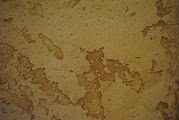Internal lime plasterwork in Italian farmhouse
Over the last couple of weeks we carried out the application of the first coats of lime plastering in this farmhouse in the Italian countryside.The background was a mixture of stone work and rubble layed in lime mortar .The lime seems to have been made locally ,much of it can be seen to have large lumps of unmixed lime among the different aggregates some of which seem to have been sands and some of which were what I imagine to be local clays /earth.The structure of the stonework itself although old and seemingly haphazard was constructerd as I have seen many times with large stones and large mortar joints with small stones and brick used as infill in these joints.
We inspected the existing mix and although it would be good to get it analysed, there is no way we could replicate this exact mix so we used a lime putty and sand mix. I think the aim here was to try to apply a functional material, meaning that the plasterwork was compatable with a lime mortar background, flexible and breathable as well as being aesthetically pleasant.
We first applied a scatch coat to cover the whole area.We used a combination of the Italian method of throwing the mortar on the wall where the wall had big hollows and applying the material using the laying on trowel where the wall was flatter thereby doing our bit for European harmony and I like to think for world peace There was very little suction on the stonework so we waited some days for the mortar to harden/carbonate naturally.This was not really a huge problem since there was quite a large area to do.
After several days and a break to prune and feed some olive trees a new experience for a Londoner we applied a second or float coat. We did not try to straighten the walls, mainly because they were impossible to plumb up(there is only so much lime and sand in the world) and also to respect tradition .This was a canteen area where wine was made ,animals kept meat cured and a style of life lived for hundereds of years.We left the walls showing their shape and tried to keep things like nitches intact. We also left the old timber lintels exposed We floated up the work using small hand made floats leaving it consolidated ready for a top or stucco coat at a later date once the background has had a chance to carbonate
In the end the weather changed and fortunately we had finished what we had to do so we will return and put on the top coat later in the year
 |
| The old church serving a population of about 15 |
 |
| existing stonework note the rubble infills |
 |
| sharp sand and much better shovel no backache with this model |
 |
| mortar mix |
 |
First coat: note the two methods of application for different backgrounds
I should be made UN Secrectary General for my contribution to world peace
|
 |
| one for the stonemasons |
 |
| one for the plasterers |
 |
| agricultural work |
 |
| up you go |
 |
| pruning olive trees |
 |
If you look closely you can see the lumps of unmixed lime
in the existing mortar
|
 |
| application of scratch coat |
 |
| mortar |
 |
| scratch coat applied and left to harden |
 |
| float coat applied and left for top or stucco coat |
 |
| scratch coat |
 |
| walls floated and timber lintels left exposed |
 |
| thats the end of that as the weather changes |
 |
| traditional vaulted ceiling over an open archway |
 |
| we will be back when the weather changes |
Lime plastering in Italy
This is a 300 year old property in the Italian countryside (although in fairness nobody seems too certain, just that "it is very old ,who knows?") The ground floor has been used traditionally for keeping animals making wine and smoking meat.The existing plaster is a lime mortar and where possible it is being saved, altough it was in quite a bad state of repair.The lime was very possibly burnt and slaked locally, much of it had lumps of white improperly slaked lime.It had however lasted the test of time.There was a history of farmers in the uk burning lime and that was probably the case in rural Italy
Over the next couple of weeks we will make a start on applying a lime mortar,We intend to follow the contours of the stone and rubble walls and in a few places to float the walls to a true finish where appropriate
The existing mortar contained small regular sized twigs as we would use animal hair to bind the mortar.We will be using animal hair if we can find a decent supply
 |
stone walls note the existing lime plaster at the top of the wall
|
 |
brick infills built with lime mortar and poorly
covered with cement render
thats coming off |
 |
mixed backgroung with niche
|
 |
| area to be plastered |
 |
note the very unstable stonework on the right which must
be repaired before plastering |































































